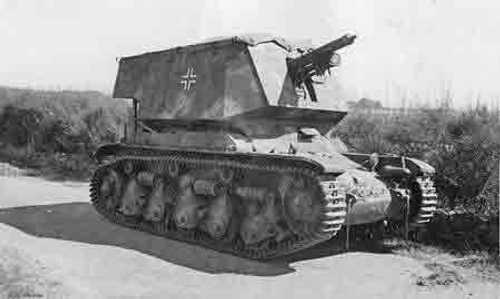
German Armored Forces & Vehicles
Defending "Fortress Jersey".
Unknown author; website credit www.theislandwiki.org
One wonders, sometimes, what the German military actually thought of Hitler's notion that the Channel Islands could usefully be employed as a sort of advance fortress in mainland France's Atlantic Wall. True, the islands of Jersey and Guernsey were heavily garrisoned, and Alderney was turned into a virtual concentration/labour camp. Also true, all of these islands were, for their size, heavily fortified with an abundance of concrete bunkers and other emplacements, mostly constructed by unfortunate forced labourers (perhaps more accurately "slaves") based on Alderney. Fields of fire from these bunkers was carefully calculated and, to take an example with which I am familiar, an attempt to land on the north (England-facing) coast of Jersey would probably have been a very unpleasant experience for those landing. That having been said, much of the (very large quantity of) the heavy equipment employed was rather second-rate. Bunkers were generally equipped with artillery pieces captured in France and of WW1 vintage - perfectly serviceable at the time, but still rather dated. The super-bunkers and very large calibre artillery found in places in the Pas de Calais were absent. Furthermore, the fighting vehicles assigned to the Channel Islands, while numerous, had a distinctly second-string character. The French Char B featured, as did a substantial number of French light tanks. Less distinguished German or "hybrid" vehicles also featured, as in this case. This vehicles is a Panzerjager 35R 731(f). The idea here was to produce a replacement, or interim replacement, for the Panzerjager I by marrying the chassis, lower cab and engine of the French Renault R-35 light tank with the Czechoslovak Skoda-made 47mm Pak(t). The 47mm Pak(t) was a useful weapon, and the Panzerjager served, at least notionally, as a front-line weapon at least as late as Normandy. However, overall, the vehicle was not a success. It retained the original R-35 limitations of light armour, high fuel consumption, low speed and limited range with the effects of the imposition of a large (and high-profile) open-topped "box" fighting compartment; the additional weight of this superstructure accentuated the native faults of the R-35, and added excessive suspension, transmission and trackbed stress to the mix. As a result, while the Panzerjager 35R 731 served in Russia during Barbarossa and continued in "frontline" service thereafter, there appears to have been limited enthusiasm for using it in action except in case of emergency. One result of this was that a high proportion of the production (something between 150 and 200) were allocated to secondary or inactive theatres; a lot of them seem to have ended up in the Channel Islands, as with this example, which was part of a column of these vehicles abandoned opposite Millbrook Park, Jersey, at the end of the war. It appears that this vehicle was disarmed at some point before this photo was taken. Best regards, JR.
4183 Views
4/23/2014
